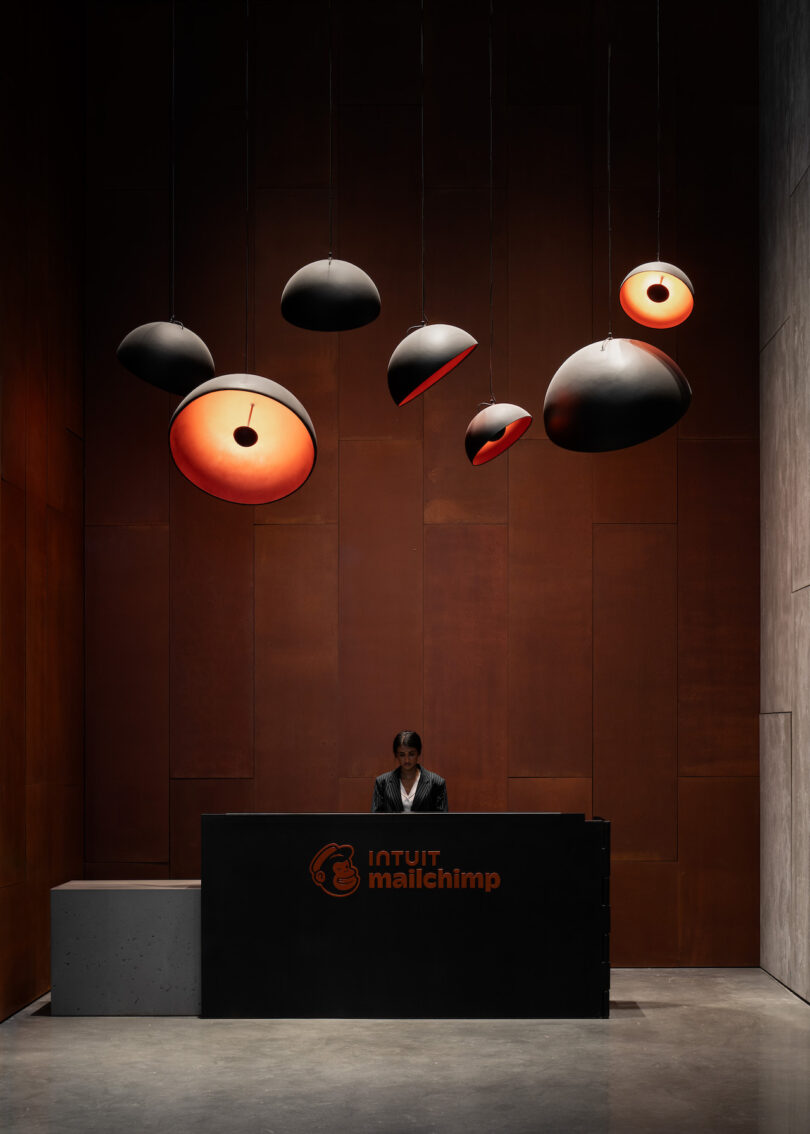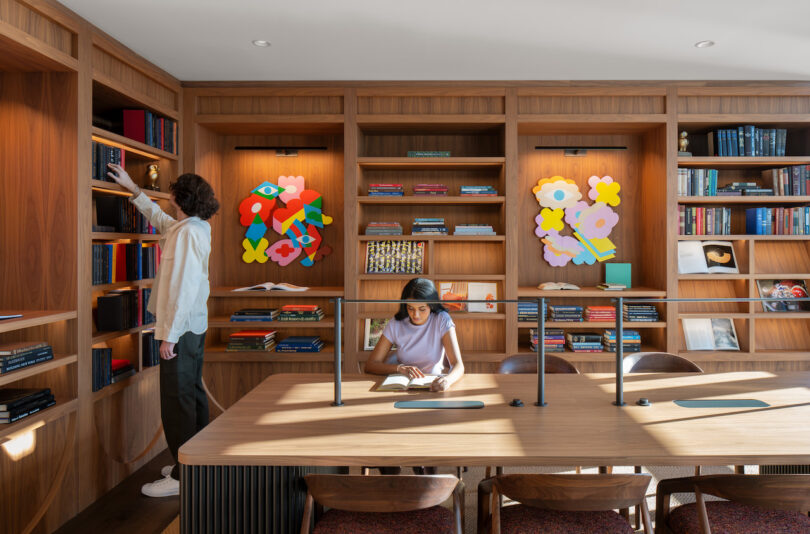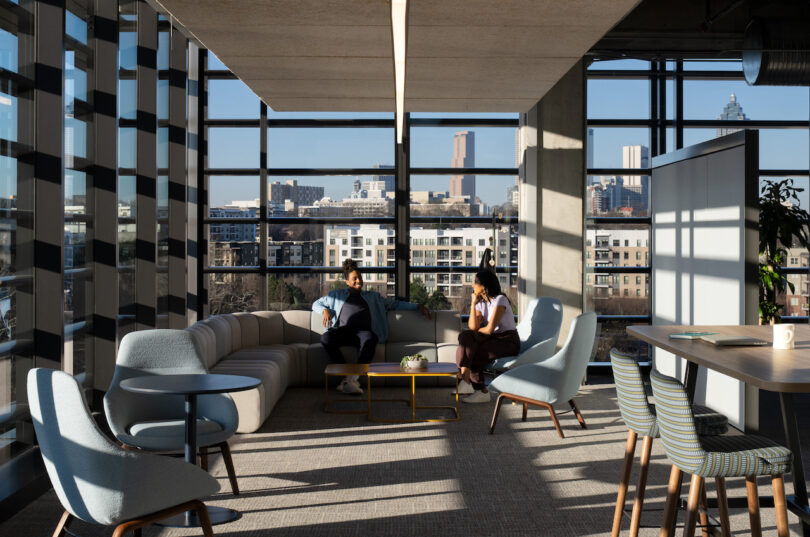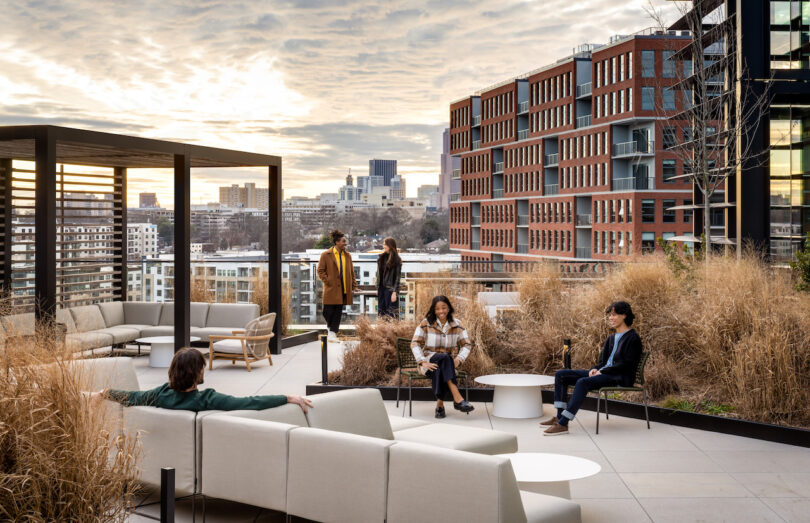This month, Intuit celebrated the opening of its new Atlanta, Georgia office, a 360,000-square-foot innovation hub that is also now home to Mailchimp, the popular email and marketing platform that the company acquired in 2021. The modern office was an extensive, collaborative effort between local design firm TVS, Studio O+A in San Francisco, Mailchimp’s in-house creative agency Wink, and Intuit’s People & Places organization to create a world-class space that fully supports hybrid work in thoughtful ways while inspiring creativity and innovation.
The office was designed around the concept of a city, which is filled with diverse neighborhoods that all represent one unified entity. But like any visitor to a new city, we need a knowledgable tour guide to (virtually!) walk us through the space and give us a lay of the land, which is why we’re excited to have Christian Widlic, Group Creative Director at Wink, here for a chat. Christian shares more behind the makings of Intuit’s “cityscape,” the building’s current progress towards LEED® Gold Certification, and how companies can help its employees do the best work (spoiler alert: it’s not pizza parties).
Can you elaborate on the process of designing the office to mimic a city with different neighborhoods? What were the different team needs and work styles that you tried to address in each neighborhood?
Our design challenge with Intuit’s Atlanta office was really to combine the best parts of working from an office and your home, so the comfort, ease, and focus you get at home, combined with the collaboration, inspiration, energy, and spontaneous interaction you get from an office. We imagined this space as a lively cityscape that mirrors the vibrancy of a bustling city all inside one unified office. In a city, you can walk from neighborhood to neighborhood and experience completely different energies and visuals, while distinctly feeling you’re still in the city. This idea inspired how we’ve designed the office.
Intuit’s Atlanta office is spread across nine floors and is segmented into distinct “neighborhoods,” each a reflection of the various business departments that come together to form the Mailchimp “city.” The neighborhoods serve as designated zones for different teams (marketing, communications, IT, creative, etc.) and are designed to flexibly accommodate various work styles and team needs. Each neighborhood has a distinct look and feel, color scheme, furniture style, art program, and even storefronts [meeting rooms] inspired by our customers. This united but unique approach means the teams working within each neighborhood can personalize the space so they can focus on tasks at hand or problem solve together. The approach also helps with wayfinding and navigating a large space. The color palette of each floor is even inspired by different neighborhoods in our home, Atlanta.
And just like a city, there are a bunch of unique places to explore and get inspired: libraries, maker spaces, rooftops, hidden bars (rooted in our history, we designed and built a custom Tiki Room), town square, coffee shops, wellness rooms, and more. Specifically for the creative team, there’s a state-of-the-art media production space equipped with a cyc wall for photography and filmmaking, and recording areas for podcasting – all to support Mailchimp Presents content development and other content created by Wink. For the IT team, there’s a TechKnow Bar, similar to a Genius Bar, where they can directly and easily interact with employees who need in-person tech support.
We love that the extensive art program features murals commissioned by artists and Intuit customers. Could you share some insights into the selection process for these artworks and how they were integrated into the office design to inspire creativity and collaboration among employees?
Going back to our design challenge, we wanted the entire office to feel like an elevated home while inspiring creativity and innovation. We commissioned 270 works of art, curated into 9 different art movements ranging from minimalism to surrealism – one for each floor. We have a rich office history of art and murals, and it was important to us to keep the Intuit Mailchimp spirit present on our walls in an elevated way without using our logo everywhere.
The process of curating the artists started with looking inward – we’re a global brand and we wanted to reflect our customers on our walls — diverse, global, and ranging from well-known to up-and-coming artists. We got the entire creative team to share artists they admire and are inspired by, and started the selection process from there. There are so many incredible artists in the world, so narrowing down to 270 was not an easy task. Some of the selected artists are in fact Intuit customers themselves. Once we started reaching out to the artists sharing the office gallery concept it was fantastic to see how excited they were.
We know that offices today are competing with the comfort of peoples’ homes, and so we wanted the office and its art here to feel like a gallery, which inspires, calms the mind, and gives employees an experience that they can’t get at home. There are so many benefits to having exposure to art, including improving our overall well-being, making us more open to learning and problem-solving, and potentially making us happier.
You can learn more about the art here.
The office design includes a variety of spaces dedicated to innovation, connection, and comfort. How did you approach balancing the need for collaborative spaces with areas designed for focused, heads-down work?
In approaching the balance between collaborative spaces and areas for focused work, our design strategy was rooted in the principle of versatility and functionality. We aimed to create an office environment that seamlessly accommodates both collaboration and individual focus, catering to the diverse needs of our employees.
To achieve this balance, we strategically allocated spaces within the office layout for collaboration, such as open meeting areas, brainstorming zones, team homerooms, and communal workspaces. These spaces are designed to foster innovation, encourage teamwork, and facilitate dynamic interactions among team members.
At the same time, we recognized the importance of providing areas for focused, heads-down work. Quiet zones, private offices, and secluded workstations are strategically integrated into the design to provide employees with the privacy and concentration they need to tackle tasks that require deep focus.
We designed these spaces to embody our core design principles of flexibility, comfort, and connection. This approach cultivated an environment where our employees feel at ease, inspired, and driven to succeed.
Sustainability is highlighted as a key focus of the building, with targets for LEED® Gold Certification and Fitwel Certification. Could you provide more details about the specific sustainable design features incorporated into the office, and how they contribute to employee well-being and environmental stewardship?
The building is targeting LEED® Gold Certification and Fitwel certification. The building design team utilized extensive daylight and thermal modeling to create a custom facade to enhance building performance while maintaining access to natural daylight and thermal comfort for occupants. Optimizing floorplates and nearly 14′ floor-to-floor heights further maximize spatial daylight autonomy, as do an increased investment in plants throughout the office, which bring a little bit of the outside in.
One factor of achieving Fitwel certification involves encouraging employees to take the stairs, so we designed signage with inspiring Haikus to promote taking the stairs, and even painted the inside of the three stairwells to motivate you to walk. That way employees can walk through the clouds, the flowers, or the stars on their way up or down the stairs.
That is one example of how we used thoughtful design to contribute to employee well-being and environmental stewardship. No detail was lost, and every single part of the office – from sound to lighting to overall finishes– was carefully considered, making the entire space feel curated, like your home.
The workplace has changed so much since 2020, and even now in 2024, there seems to be a tide turning, with more prevalent requests to return to the office alongside workers advocating for the remote/hybrid work models. In the new modern office, what strategies or features do you believe will be essential for creating spaces that promote collaboration, creativity, and wellness in this ever-changing landscape?
The way we work has fundamentally changed. After working from home for so long, and absorbing all the benefits (and drawbacks) that go with working outside of an office, we need to be cognizant that the office is, in many cases, competition with the home. That means that we needed to find opportunities to make it worthwhile to commute into the office multiple days a week. And that can’t just be a pizza party here or there (though pizza parties never hurt!) It means that we had to create a space where employees can do things they can’t do at home. We designed a space where employees can have face-to-face interactions with colleagues, have brainstorms that change the way they might approach a project, create visual materials that require tech and expertise they can’t find in a home office, or participate in hands-on workshops with community leaders alongside their colleagues for creative time and socialization. All of these amenities are designed to bring our people together to do the best work of their lives.
Photography by Seamus Payne.







































